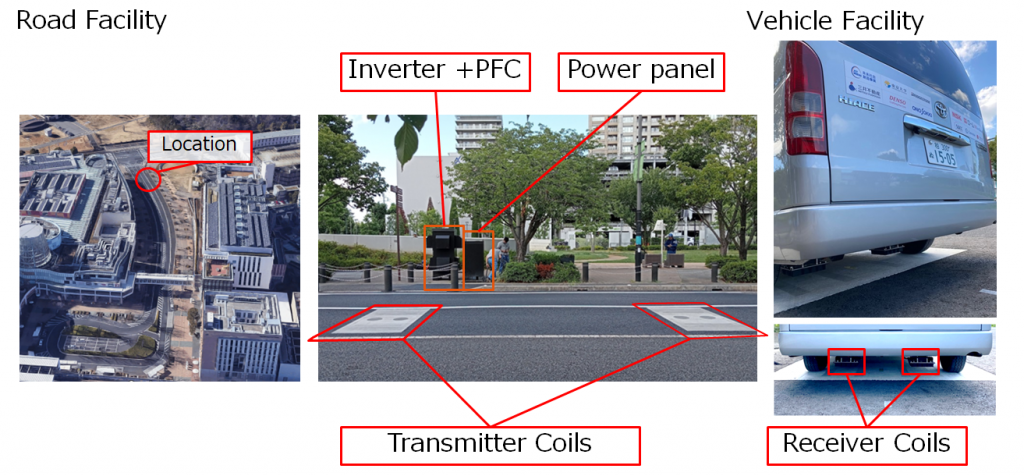As of May 31, 2024
- Theme:Study on the introduction of new transport modes to expand mobility options within the region.
- chairman:Professor Hiroshi Fujimoto, University of Tokyo
Main activities up to 2023
- 1.Wireless power supply system
-
- Japan’s first demonstration experiment of power transfer while driving on a public road was started at the Chouji-road leading to the roundabout at the west exit of Kashiwanoha Campus Station. The mayor of Kashiwa participated in the starting ceremony for the public road demonstration, and the activities were covered by NHK and many other media.
- In terms of research, data obtained from the demonstration tests was analysed and control technology combining vehicle motion control and in-transit power supply was studied.
- 2. study of a mobility system based on the Kashiwanoha Campus Town
- (1) For the University of Tokyo two-seater vehicle, the environment was prepared so that it could run again in Tateyama City. As it is desirable for this vehicle to be operated by the NPO Gonjiro in Tateyama City, which is the local activity base of the Akiko Okabe Laboratory of the Graduate School of Frontier Sciences of the University of Tokyo, the Ministry of Land, Infrastructure and Transport’s ‘Certification for Micro-mobility (driving area: Kashiwa City)’, which was received in the name of this council, was cancelled and the vehicle was renamed as NPO Gonjiro. (The vehicle is also scheduled to be transferred from the University of Tokyo to NPO Gonjiro after certification is obtained.) Therefore, formally, these vehicles are no longer under the control of the CIPP and Todai, but the CIPP will continue to collect and utilise information on the status and results of their utilisation in Tateyama City.
- (2) The Nissan New Mobility Concept Vehicles have been prepared to enable the planning and preparation of test-ride experiments.
- (3) With the lifting of the ban on the use of specified small mopeds, which came into force in July 2023, the use of electric kick-skater-type vehicles (two-wheeled vehicles that can be ridden standing up) has led to many problems with accidents and violations (so-called ‘full electric bicycles’ that deviate from the standards for riding, and kick skaters that go too fast). The number of motorised vehicles has increased in recent years. As for other types of vehicles (sit-down, three- and four-wheeled vehicles), several prototypes were presented by manufacturers at the Tokyo Mobility Show in autumn 2023.
Draft activity plan for 2024
- 1. wireless power supply system
- This year, we plan to continue with Japan’s first demonstration of power transfer while driving on public roads. In addition, research will be conducted on the following themes as basic research.
- Study of design and control methods for a wireless power charging system to be installed near intersections.
- Research on improving the robustness of wireless power charging systems
- 2. social demonstration experiments of mobility systems in Kashiwanoha Campus Town
- (1) Obtain information on the usage status of the University of Tokyo two-seater vehicle, which was transferred to the NPO Gonjiro in Tateyama City, as described above in the FY2023 Activity Status.
- (2) As for the Nissan New Mobility Concept vehicles, maintain a state of readiness for planning and preparation of test-ride experiments.
- (3) Continue to monitor developments with regard to the specified small moped ‘sit-only, three-wheeled and four-wheeled vehicles’. In addition, NNC Mobility (Itabashi-ku, Tokyo), a general incorporated association working towards the practical use of two-seater vehicles of the same size as the University of Tokyo two-seater ultra-compact mobility vehicles (which can be driven on public roads), is lobbying the government (Tokyo Metropolitan Government, Cabinet Secretariat, Ministry of Economy, Trade and Industry, etc.) to establish a number classification that would enable them to be driven on public roads. Information will also be collected on this.


